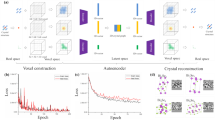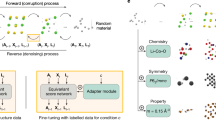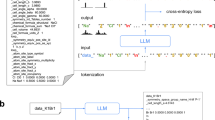Abstract
Designing periodicity-aware, invariant and invertible representations provides an opportunity for the inverse design of crystalline materials with desired properties by generative models. This objective requires optimizing representations and refining the architecture of generative models, yet its feasibility remains uncertain, given current progress in molecular inverse generation. In this Perspective, we highlight the progress of various methods for designing representations and generative schemes for crystalline materials, discuss the challenges in the field and propose a roadmap for future developments.
This is a preview of subscription content, access via your institution
Access options
Access Nature and 54 other Nature Portfolio journals
Get Nature+, our best-value online-access subscription
$32.99 / 30 days
cancel any time
Subscribe to this journal
Receive 12 digital issues and online access to articles
$119.00 per year
only $9.92 per issue
Buy this article
- Purchase on SpringerLink
- Instant access to full article PDF
Prices may be subject to local taxes which are calculated during checkout





Similar content being viewed by others
References
Wieder, B. J. et al. Topological materials discovery from crystal symmetry. Nat. Rev. Mater. 7, 196–216 (2021).
Firaha, D. et al. Predicting crystal form stability under real-world conditions. Nature 623, 324–328 (2023).
Guan, X., Heindel, J. P., Ko, T., Yang, C. & Head-Gordon, T. Using machine learning to go beyond potential energy surface benchmarking for chemical reactivity. Nat. Comput Sci. 3, 965–974 (2023).
Deng, B. et al. CHGNet as a pretrained universal neural network potential for charge-informed atomistic modelling. Nat. Mach. Intell. 5, 1031–1041 (2023).
Ko, T. W. & Ong, S. P. Recent advances and outstanding challenges for machine learning interatomic potentials. Nat. Comput. Sci. 3, 998–1000 (2023).
Wan, K., He, J. & Shi, X. Construction of high accuracy machine learning interatomic potential for surface/interface of nanomaterials—a review. Adv. Mater. 36, 2305758 (2024).
Yan, D., Smith, A. D. & Chen, C.-C. Structure prediction and materials design with generative neural networks. Nat. Comput. Sci. 3, 572–574 (2023).
Gusev, V. V. et al. Optimality guarantees for crystal structure prediction. Nature 619, 68–72 (2023).
Wang, X. et al. Data-driven prediction of complex crystal structures of dense lithium. Nat. Commun. 14, 2924 (2023).
Anstine, D. M. & Isayev, O. Generative models as an emerging paradigm in the chemical sciences. J. Am. Chem. Soc. 145, 8736–8750 (2023).
Singh, S. & Sunoj, R. B. Molecular machine learning for chemical catalysis: prospects and challenges. Acc. Chem. Res. 56, 402–412 (2023).
Jiang, S., Dieng, A. B. & Webb, M. A. Property-guided generation of complex polymer topologies using variational autoencoders. npj Comput. Mater. 10, 139 (2024).
Krenn, M. et al. On scientific understanding with artificial intelligence. Nat. Rev. Phys. 4, 761–769 (2022).
Kang, Y. & Kim, J. ChatMOF: an artificial intelligence system for predicting and generating metal–organic frameworks using large language models. Nat. Commun. 15, 4705 (2024).
Wang, Z., Chen, A., Tao, K., Han, Y. & Li, J. MatGPT: a vane of materials informatics from past, present, to future. Adv. Mater. 36, 2306733 (2024).
Walters, W. P. & Murcko, M. Assessing the impact of generative AI on medicinal chemistry. Nat. Biotechnol. 38, 143–145 (2020).
Du, Y. et al. Machine learning-aided generative molecular design. Nat. Mach. Intell. 6, 589–604 (2024).
Zhung, W., Kim, H. & Kim, W. Y. 3D molecular generative framework for interaction-guided drug design. Nat. Commun. 15, 2688 (2024).
Jiang, Y. et al. PocketFlow is a data-and-knowledge-driven structure-based molecular generative model. Nat. Mach. Intell. 6, 326–337 (2024).
Chang, J. & Ye, J. C. Bidirectional generation of structure and properties through a single molecular foundation model. Nat. Commun. 15, 2323 (2024).
Westermayr, J., Gilkes, J., Barrett, R. & Maurer, R. J. High-throughput property-driven generative design of functional organic molecules. Nat. Comput. Sci. 3, 139–148 (2023).
Weininger, D. SMILES, a chemical language and information system. 1. Introduction to methodology and encoding rules. J. Chem. Inf. Comput. Sci. 28, 31–36 (1988).
Heller, S. R., McNaught, A., Pletnev, I., Stein, S. & Tchekhovskoi, D. InChI, the IUPAC international chemical identifier. J. Cheminform. 7, 23 (2015).
Rogers, D. & Hahn, M. Extended-connectivity fingerprints. J. Chem. Inf. Model. 50, 742–754 (2010).
Krenn, M., Häse, F., Nigam, A., Friederich, P. & Aspuru-Guzik, A. Self-referencing embedded strings (SELFIES): a 100% robust molecular string representation. Mach. Learn. Sci. Technol. 1, 045024 (2020).
Park, H., Li, Z. & Walsh, A. Has generative artificial intelligence solved inverse materials design? Matter 7, 2355–2367 (2024).
Butler, K. T., Davies, D. W., Cartwright, H., Isayev, O. & Walsh, A. Machine learning for molecular and materials science. Nature 559, 547–555 (2018).
Friederich, P., Häse, F., Proppe, J. & Aspuru-Guzik, A. Machine-learned potentials for next-generation matter simulations. Nat. Mater. 20, 750–761 (2021).
Hippalgaonkar, K. et al. Knowledge-integrated machine learning for materials: lessons from gameplaying and robotics. Nat. Rev. Mater. 8, 241–260 (2023).
Jain, A. et al. The Materials Project: a materials genome approach to accelerating materials innovation. APL Mater. 1, 011002 (2013).
Draxl, C. & Scheffler, M. NOMAD: the FAIR concept for big data-driven materials science. MRS Bull. 43, 676–682 (2018).
Sbailò, L., Fekete, Á., Ghiringhelli, L. M. & Scheffler, M. The NOMAD artificial-intelligence toolkit: turning materials-science data into knowledge and understanding. npj Comput. Mater. 8, 250 (2022).
Curtarolo, S. et al. AFLOW: an automatic framework for high-throughput materials discovery. Comput. Mater. Sci. 58, 218–226 (2012).
Merchant, A. et al. Scaling deep learning for materials discovery. Nature 624, 80–85 (2023).
Wang, R. et al. MatSwarm: trusted swarm transfer learning driven materials computation for secure big data sharing. Nat. Commun. 15, 9290 (2024).
Xie, T. & Grossman, J. C. Crystal graph convolutional neural networks for an accurate and interpretable prediction of material properties. Phys. Rev. Lett. 120, 145301 (2018).
Chen, C., Ye, W., Zuo, Y., Zheng, C. & Ong, S. P. Graph networks as a universal machine learning framework for molecules and crystals. Chem. Mater. 31, 3564–3572 (2019).
Chen, C. & Ong, S. P. A universal graph deep learning interatomic potential for the periodic table. Nat. Comput. Sci. 2, 718–728 (2022).
Yan, K., Liu, Y., Lin, Y. & Ji, S. Periodic graph transformers for crystal material property prediction. In Advances in Neural Information Processing Systems (eds Oh, A. H. et al.) 1096 (Curran Associates Inc., 2022).
Banik, S. et al. CEGANN: crystal edge graph attention neural network for multiscale classification of materials environment. npj Comput. Mater. 9, 23 (2023).
Noh, J. et al. Inverse design of solid-state materials via a continuous representation. Matter 1, 1370–1384 (2019).
Long, T. et al. Constrained crystals deep convolutional generative adversarial network for the inverse design of crystal structures. npj Comput. Mater. 7, 66 (2021).
Court, C. J., Yildirim, B., Jain, A. & Cole, J. M. 3-D inorganic crystal structure generation and property prediction via representation learning. J. Chem. Inf. Model. 60, 4518–4535 (2020).
Yan, Z., Wei, D., Li, X. & Chung, L. W. Accelerating reliable multiscale quantum refinement of protein–drug systems enabled by machine learning. Nat. Commun. 15, 4181 (2024).
Siebenmorgen, T. et al. MISATO: machine learning dataset of protein–ligand complexes for structure-based drug discovery. Nat. Comput. Sci. 4, 367–378 (2024).
Yang, M., Raucci, U. & Parrinello, M. Reactant-induced dynamics of lithium imide surfaces during the ammonia decomposition process. Nat. Catal. 6, 829–836 (2023).
Gu, Q. et al. Deep learning tight-binding approach for large-scale electronic simulations at finite temperatures with ab initio accuracy. Nat. Commun. 15, 6772 (2024).
Kim, S., Noh, J., Gu, G. H., Aspuru-Guzik, A. & Jung, Y. Generative adversarial networks for crystal structure prediction. ACS Cent. Sci. 6, 1412–1420 (2020).
Ren, Z. et al. An invertible crystallographic representation for general inverse design of inorganic crystals with targeted properties. Matter 5, 314–335 (2022).
Nanotechnology for Microelectronics and Optoelectronics (Elsevier, 2006); https://doi.org/10.1016/B978-0-08-044553-3.X5000-0
Batzner, S. et al. E(3)-equivariant graph neural networks for data-efficient and accurate interatomic potentials. Nat. Commun. 13, 2453 (2022).
Phan, B. K. et al. Gas permeability, diffusivity, and solubility in polymers: simulation-experiment data fusion and multi-task machine learning. npj Comput. Mater. 10, 186 (2024).
Zheng, X., Zheng, P. & Zhang, R.-Z. Machine learning material properties from the periodic table using convolutional neural networks. Chem. Sci. 9, 8426–8432 (2018).
Yang, S. et al. Scalable diffusion for materials generation. In 12th International Conference on Learning Representations (ICLR, 2024).
Van De Ven, G. M., Tuytelaars, T. & Tolias, A. S. Three types of incremental learning. Nat. Mach. Intell. 4, 1185–1197 (2022).
Dohare, S. et al. Loss of plasticity in deep continual learning. Nature 632, 768–774 (2024).
Antunes, L. M., Butler, K. T. & Grau-Crespo, R. Crystal structure generation with autoregressive large language modeling. Nat. Commun. 15, 10570 (2024).
Xiao, H. et al. An invertible, invariant crystal representation for inverse design of solid-state materials using generative deep learning. Nat. Commun. 14, 7027 (2023).
Spicher, S. & Grimme, S. Robust atomistic modeling of materials, organometallic, and biochemical systems. Angew. Chem. Int. Ed. 132, 15795–15803 (2020).
Zang, X., Zhao, X. & Tang, B. Hierarchical molecular graph self-supervised learning for property prediction. Commun. Chem. 6, 34 (2023).
Nouira, A., Sokolovska, N. & Crivello, J.-C. CrystalGAN: learning to discover crystallographic structures with generative adversarial networks. Preprint at https://arxiv.org/abs/1810.11203 (2018).
Kresse, G. & Furthmüller, J. Efficient iterative schemes for ab initio total-energy calculations using a plane-wave basis set. Phys. Rev. B 54, 11169–11186 (1996).
Zhao, Y. et al. Physics guided deep learning for generative design of crystal materials with symmetry constraints. npj Comput. Mater. 9, 38 (2023).
Kusne, A. G. et al. On-the-fly closed-loop materials discovery via Bayesian active learning. Nat. Commun. 11, 5966 (2020).
Zhang, Y. et al. Machine learning on microstructure–property relationship of lithium-ion conducting oxide solid electrolytes. Nano Lett. 24, 5292–5300 (2024).
Xie, T., Fu, X., Ganea, O.-E., Barzilay, R. & Jaakkola, T. Crystal diffusion variational autoencoder for periodic material generation. In 10th International Conference on Learning Representations (ICLR, 2022).
Wines, D., Xie, T. & Choudhary, K. Inverse design of next-generation superconductors using data-driven deep generative models. J. Phys. Chem. Lett. 14, 6630–6638 (2023).
Zeni, C. et al. A generative model for inorganic materials design. Nature 639, 624–632 (2025).
Song, Y. et al. Score-based generative modeling through stochastic differential equations. In 9th International Conference on Learning Representations (ICLR, 2021).
Sultanov, A., Crivello, J.-C., Rebafka, T. & Sokolovska, N. Data-driven score-based models for generating stable structures with adaptive crystal cells. J. Chem. Inf. Model. 63, 6986–6997 (2023).
Karniadakis, G. E. et al. Physics-informed machine learning. Nat. Rev. Phys. 3, 422–440 (2021).
Bastek, J.-H. & Kochmann, D. M. Inverse design of nonlinear mechanical metamaterials via video denoising diffusion models. Nat. Mach. Intell. 5, 1466–1475 (2023).
Zhang, L., Rao, A. & Agrawala, M. Adding conditional control to text-to-image diffusion models. In IEEE International Conference on Computer Vision (ICCV) (IEEE, 2023).
Bengio, E., Jain, M., Korablyov, M., Precup, D. & Bengio, Y. Flow network based generative models for non-iterative diverse candidate generation. In Advances in Neural Information Processing Systems, 27381–27394 (Curran Associates, Inc., 2022).
Hernandez-Garcia, A. et al. Crystal-GFN: sampling crystals with desirable properties and constraints. In AI4MAt 2023 - AI for Accelerated Materials Design workshop at 37th Conference on Neural Information Processing Systems (NeurIPS, 2023).
Galanakis, N. & Tuckerman, M. E. Rapid prediction of molecular crystal structures using simple topological and physical descriptors. Nat. Commun. 15, 9757 (2024).
Karimitari, N. et al. Accurate crystal structure prediction of new 2D hybrid organic–inorganic perovskites. J. Am. Chem. Soc. 146, 27392–27404 (2024).
Jumper, J. et al. Highly accurate protein structure prediction with AlphaFold. Nature 596, 583–589 (2021).
Abramson, J. et al. Accurate structure prediction of biomolecular interactions with AlphaFold 3. Nature 630, 493–500 (2024).
Fei, N. et al. Towards artificial general intelligence via a multimodal foundation model. Nat. Commun. 13, 3094 (2022).
Cohen Kalafut, N., Huang, X. & Wang, D. Joint variational autoencoders for multimodal imputation and embedding. Nat. Mach. Intell. 5, 631–642 (2023).
Xiao, Y. et al. Electrolyte melt infiltration for scalable manufacturing of inorganic all-solid-state lithium-ion batteries. Nat. Mater. 20, 984–990 (2021).
Cui, L. et al. A cathode homogenization strategy for enabling long-cycle-life all-solid-state lithium batteries. Nat. Energy 9, 1084–1094 (2024).
Lu, S. et al. Towards n-type conductivity in hexagonal boron nitride. Nat. Commun. 13, 3109 (2022).
Wang, H., Zhang, L., Han, J. & E, W. DeePMD-kit: a deep learning package for many-body potential energy representation and molecular dynamics. Comput. Phys. Commun. 228, 178–184 (2018).
Joll, K., Schienbein, P., Rosso, K. M. & Blumberger, J. Machine learning the electric field response of condensed phase systems using perturbed neural network potentials. Nat. Commun. 15, 8192 (2024).
Batatia, I. et al. A foundation model for atomistic materials chemistry. Preprint at https://arxiv.org/abs/2401.00096 (2024).
Li, C.-N., Liang, H.-P., Zhao, B.-Q., Wei, S.-H. & Zhang, X. Machine learning assisted crystal structure prediction made simple. J. Mater. Inf. 4, 15 (2024).
Hessmann, S. S. P. et al. Accelerating crystal structure search through active learning with neural networks for rapid relaxations. npj Comput. Mater. 11, 44 (2025).
Yang, H. et al. MatterSim: a deep learning atomistic model across elements, temperatures and pressures. Preprint at https://arxiv.org/abs/2405.04967 (2024).
Ong, S. P. et al. Python Materials Genomics (pymatgen): a robust, open-source Python library for materials analysis. Comput. Mater. Sci. 68, 314–319 (2013).
Hjorth Larsen, A. et al. The atomic simulation environment—a Python library for working with atoms. J. Phys. Condens. Matter 29, 273002 (2017).
Moret, M., Friedrich, L., Grisoni, F., Merk, D. & Schneider, G. Generative molecular design in low data regimes. Nat. Mach. Intell. 2, 171–180 (2020).
Ramsundar, B. et al. Deep Learning for the Life Sciences (O’Reilly Media, 2019).
Ward, L. et al. Matminer: an open source toolkit for materials data mining. Comput. Mater. Sci. 152, 60–69 (2018).
Dunn, A., Wang, Q., Ganose, A., Dopp, D. & Jain, A. Benchmarking materials property prediction methods: the Matbench test set and Automatminer reference algorithm. npj Comput. Mater. 6, 138 (2020).
Li, H. et al. Deep-learning density functional theory Hamiltonian for efficient ab initio electronic-structure calculation. Nat. Comput. Sci. 2, 367–377 (2022).
Gong, X., Louie, S. G., Duan, W. & Xu, Y. Generalizing deep learning electronic structure calculation to the plane-wave basis. Nat. Comput. Sci. 4, 752–760 (2024).
Yang, Z. et al. Scalable crystal structure relaxation using an iteration-free deep generative model with uncertainty quantification. Nat. Commun. 15, 8148 (2024).
Wang, Y., Lv, J., Zhu, L. & Ma, Y. CALYPSO: a method for crystal structure prediction. Comput. Phys. Commun. 183, 2063–2070 (2012).
Hajinazar, S. & Zurek, E. XtalOpt version 13: Multi-objective evolutionary search for novel functional materials. Comput. Phys. Commun. 304, 109306 (2024).
Wang, Z. et al. AlphaMat: a material informatics hub connecting data, features, models and applications. npj Comput. Mater. 9, 130 (2023).
Zhao, X.-G. et al. JAMIP: an artificial-intelligence aided data-driven infrastructure for computational materials informatics. Sci. Bull. 66, 1973–1985 (2021).
Jacobs, R. et al. The Materials Simulation Toolkit for Machine learning (MAST-ML): an automated open source toolkit to accelerate data-driven materials research. Comput. Mater. Sci. 176, 109544 (2020).
Hu, J. et al. MaterialsAtlas.org: a materials informatics web app platform for materials discovery and survey of state-of-the-art. npj Comput. Mater. 8, 65 (2022).
Tran, R. et al. The Open Catalyst 2022 (OC22) dataset and challenges for oxide electrocatalysts. ACS Catal. 13, 3066–3084 (2023).
Zhong, X. et al. Explainable machine learning in materials science. npj Comput. Mater. 8, 204 (2022).
Wang, Z. et al. IonML: a physically inspired machine learning platform to directed design superionic conductors. Energy Stor. Mater. 59, 102781 (2023).
Behler, J. & Parrinello, M. Generalized neural-network representation of high-dimensional potential-energy surfaces. Phys. Rev. Lett. 98, 146401 (2007).
Wang, Z., Han, Y., Li, J. & He, X. Combining the fragmentation approach and neural network potential energy surfaces of fragments for accurate calculation of protein energy. J. Phys. Chem. B 124, 3027–3035 (2020).
Han, Y. et al. Machine learning accelerates quantum mechanics predictions of molecular crystals. Phys. Rep. 934, 1–71 (2021).
Zeng, Z. et al. Mechanistic insight on water dissociation on pristine low-index TiO2 surfaces from machine learning molecular dynamics simulations. Nat. Commun. 14, 6131 (2023).
Abdin, O. & Kim, P. M. Direct conformational sampling from peptide energy landscapes through hypernetwork-conditioned diffusion. Nat. Mach. Intell. 6, 775–786 (2024).
Van De Walle, A., Asta, M. & Ceder, G. The alloy theoretic automated toolkit: a user guide. Calphad 26, 539–553 (2002).
Acknowledgements
This project is partially supported by the Eric and Wendy Schmidt AI in Science Postdoctoral Fellowship, a program of Schmidt Sciences, LLC.
Author information
Authors and Affiliations
Contributions
Z.W.: conceptualization, methodology, visualization, data curation, writing—original draft. F.Y.: conceptualization, methodology, supervision, resources, writing—review and editing.
Corresponding author
Ethics declarations
Competing interests
The authors declare no competing interests.
Peer review
Peer review information
Nature Computational Science thanks Ming Hu and the other, anonymous, reviewer(s) for their contribution to the peer review of this work. Primary Handling Editor: Kaitlin McCardle, in collaboration with the Nature Computational Science team.
Additional information
Publisher’s note Springer Nature remains neutral with regard to jurisdictional claims in published maps and institutional affiliations.
Supplementary information
Supplementary Table 1
An overview of generative models of crystalline materials design. This table summarizes the representative studies from this Perspective, highlighting their main representations, artificial intelligence architectures, materials applications, properties and access links.
Rights and permissions
Springer Nature or its licensor (e.g. a society or other partner) holds exclusive rights to this article under a publishing agreement with the author(s) or other rightsholder(s); author self-archiving of the accepted manuscript version of this article is solely governed by the terms of such publishing agreement and applicable law.
About this article
Cite this article
Wang, Z., You, F. Leveraging generative models with periodicity-aware, invertible and invariant representations for crystalline materials design. Nat Comput Sci 5, 365–376 (2025). https://doi.org/10.1038/s43588-025-00797-7
Received:
Accepted:
Published:
Issue date:
DOI: https://doi.org/10.1038/s43588-025-00797-7



